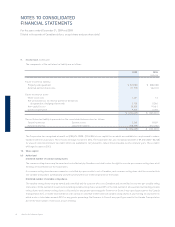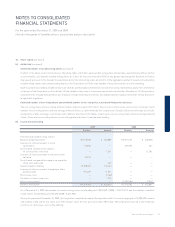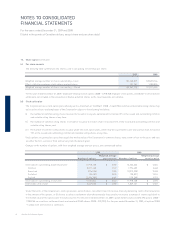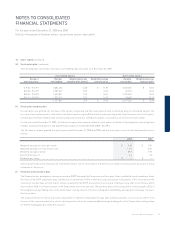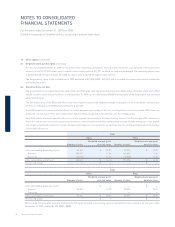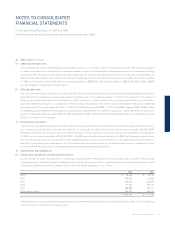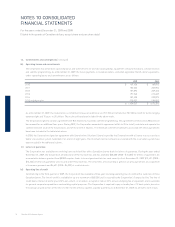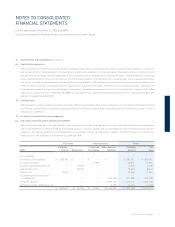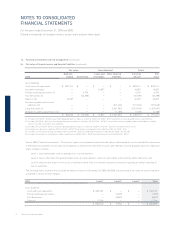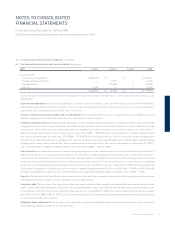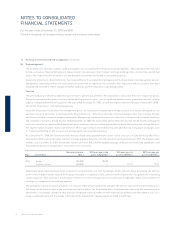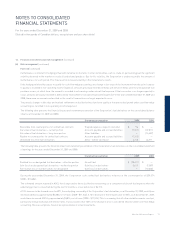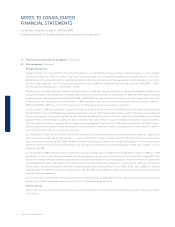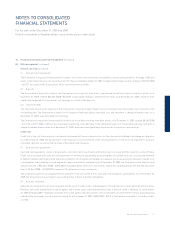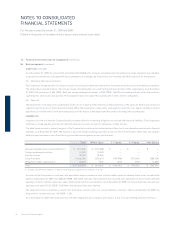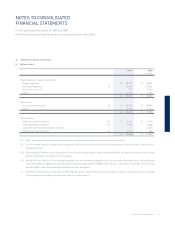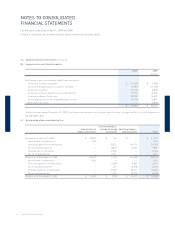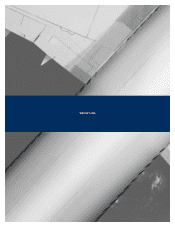Westjet 2009 Annual Report Download - page 104
Download and view the complete annual report
Please find page 104 of the 2009 Westjet annual report below. You can navigate through the pages in the report by either clicking on the pages listed below, or by using the keyword search tool below to find specific information within the annual report.
74 WestJet 2009 Annual Report
NOTES TO CONSOLIDATED
FINANCIAL STATEMENTS
For the years ended December 31, 2009 and 2008
(Stated in thousands of Canadian dollars, except share and per share data)
13. Financial instruments and risk management (continued)
(b) Risk management
The Corporation is exposed to market, credit and liquidity risks associated with its fi nancial assets and liabilities. The Corporation will, from time
to time, use various fi nancial derivatives to reduce market risk exposures from changes in foreign exchange rates, interest rates and jet fuel
prices. The Corporation does not hold or use any derivative instruments for trading or speculative purposes.
Overall, the Corporation’s Board of Directors has responsibility for the establishment and approval of the Corporation’s risk management policies.
Management continually perform risk assessments to ensure that all signifi cant risks related to the Corporation and its operations have been
reviewed and assessed to refl ect changes in market conditions and the Corporation’s operating activities.
Fuel risk
The airline industry is inherently dependent upon jet fuel to operate and, therefore, the Corporation is exposed to the risk of volatile fuel prices.
Fuel prices are impacted by a host of factors outside the Corporation’s control, such as signifi cant weather events, geopolitical tensions, refi nery
capacity, and global demand and supply. For the year ended December 31, 2009, aircraft fuel expense represented approximately 28% (2008 –
36%) of the Corporation’s total operating expenses.
Under the Corporation’s fuel price risk management policy, the Corporation is permitted to hedge a portion of its future anticipated jet fuel
purchases for up to 36 months, as approved by the Board of Directors. The policy establishes maximum hedging limits based on time horizon,
but does not include a minimum hedging requirement. Management continuously reviews and adjusts its strategy based on market conditions
and competitors’ positions. During the year ended December 31, 2009, the Corporation did not enter into any new fuel derivatives. Although jet
fuel is not traded on an organized North American futures exchange, there are limited opportunities to hedge directly in jet fuel through the over-
the-counter market; however, fi nancial derivatives in other crude-oil-based commodities that are traded directly on organized exchanges, such
as crude oil and heating oil, are also useful in decreasing the risk of volatile fuel prices.
As at December 31, 2009, the Corporation had a mixture of fi xed swap agreements and costless collar structures in Canadian-dollar West Texas
Intermediate (WTI) crude oil derivative contracts to hedge approximately 14% of its anticipated jet fuel requirements for 2010. The following table
outlines, as at December 31, 2009, the notional volumes per barrel (bbl.) and the weighted average strike price for fi xed swap agreements, and
the weighted average call and put prices for costless collar structures.
Upon proper qualifi cation, the Corporation accounts for its fuel derivatives as cash fl ow hedges. Under cash fl ow hedge accounting, the effective
portion of the change in the fair value of the hedging instrument is recognized in AOCL, while the ineffective portion is recognized in non-operating
income (expense). Upon maturity of the derivative instrument, the effective gains and losses previously recognized in AOCL are recorded in net
earnings as a component of aircraft fuel expense.
The Corporation’s policy for its fuel derivatives is to measure effectiveness based on the change in the intrinsic value of the fuel derivatives versus
the change in the intrinsic value of the anticipated jet fuel purchase. The Corporation elects to exclude time value from the measurement of
effectiveness; accordingly, changes in time value are recognized in non-operating income (expense) during the period the change occurs. As a
result, a signifi cant portion of the change in fair value of the Corporation’s options may be recorded as ineffective.
Year Instrument
Notional volumes
(bbl.)
WTI average strike
price (CAD$/bbl.)
WTI average call
price (CAD$/bbl.)
WTI average put
price (CAD$/bbl.)
2010 Swaps 381,000 103.09 — —
Costless collars 483,000 — 111.21 77.94


